Etchilhampton, Wiltshire | 19th August 2015 | Wheat
Note: You can click on any of the images in this blog for an enlarged view.
The second formation to appear at Etchilhampton in 2015 was also to be the last of the season. It was big, approximately 250ft in diameter, and was in a field of golden mature wheat. It looked impressive and majestic in the landscape.
The geometry of the formation was rather novel. Nine stars ‘hold hands’ around the outer of the formation with two inner rows of nine small standing and flattened blocks in each.
From the air one was immediately drawn to the ‘X’ shapes laid into the flattened crop, and as I sat down to draw this formation it was clear these X’s were a central part of the design as well as a very attractive part of the lay of the crop. There were twenty-seven X’s all together. Some of them were not used in the geometry of the design, but instead, gave anyone looking at the design an excellent pointer as to its construction. You can see some of the X’s in the large photo at the top of the page.
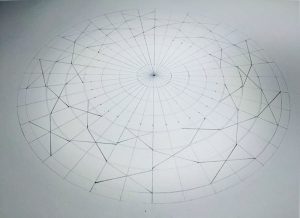
The geometric framework from which the design was constructed. Click on the image for a larger view.
The circle of the formation is divided into thirty-six segments and then seven concentric rings are created. Add in a narrow 8th outer ring to contain the entire design and the central circle and you nine. The entire design is picked from this geometric framework.
The X’s helped create the nine hexagram stars which sat around the perimeter of the design. Interestingly, because of the way the framework was set out (partially in segments which get narrower as they reach the centre) they gave the stars a kind of forced perspective, which made them narrower at the bottom and wider at the top (a nice touch if I may say so).
The number nine was infused into the very fabric of this design at every level. In addition to the nine stars – each star had six points (9 x 6 = 54), there 36 segments, and 27 crosses – all numbers reducible to nine.
As beautiful as this formation was there was however, one glaring feature (well two actually) that was immediately jarring to look at. Three of the stars appeared incomplete, with two standing blocks of wheat where the points of the stars should have been. Was this a mistake, or symbolic of something meaningful?
When I recently discussed this formation with several friends, I was slightly surprised to learn that some of them had not been able to move beyond the psychological barrier created within them by these so-called ‘mistakes’, and had simply decided they didn’t like the formation and as a consequence had been unable to engage with it in any depth.
As always, when something like this happens it always piques my interest and I begin contemplating the possible reasons for this reaction, wanting to understand what might be going on and what I might learn. You see, in the realm of the paranormal it is these strange little reactions that can tell us much about the particular phenomenon we are studying and about the paranormal in general.
At first I had looked at several ways in which these ‘blocks’ could have been meaningful from a numerical or geometrical perspective – many circles over the years have been meaningful in this way. The formation reminded me of another circle back in the year 2000 which appeared opposite Silbury Hill and had contained six pentagram stars – in a very similar fashion to the way the Etchilhampton circle contained hexagram stars – each had stars with points and empty centres.
In the Silbury Hill formation there were six stars each with five points, giving a total of thirty points. However, one of the points on one of the stars had been misplaced, giving us a total of 29 points. Researcher and geometer Michael Glickman speculated that the number twenty-nine (seen many times in crop circle design) could be a representation of the mathematical constant pi. We are all used to seeing pi in its decimal format as 3.142, but it can also be rendered as 22/7 (twenty-two divided by seven) – if we add twenty-two and seven together we get our twenty- nine.
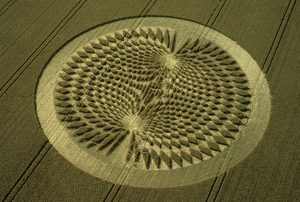
Avebury Trusloe 22/07/2000. A sixty-fold design in two halves – each with one point missing – giving two halves with 29 points in each.
Michael also pointed out that (in another of those astonishing synchronicities that abound around this subject) another circle had appeared later on in the summer at Avebury Trusloe which also pointed to pi. It was a huge elaborate design that resembled iron-filings reacting to magnetic fields. The design of this formation was sixty-fold and comprised of two halves each with 30 points. In one half the first point (point 1) was missing and in the second the last point (point 30) was missing – giving (you guessed it) 29 points in each half. And just to make sure we understood the meaning of these twenty nines, the formation had appeared on the 22nd of July or 22/7/2000 – 22/7.
Try as I might with the Etchilhampton formation, there didn’t seem to be anything significant about the numbers. Nine stars with six points each gives us fifty-four points, remove the four that are not formed and you get fifty – no mathematical constants there.
However, the number nine is repeated three times in this formation, once by the nine perimeter stars, and then twice more in the two rings of standing blocks at the centre of the formation. In the UK 999 is the number you call to summon the emergency services (like 911 in the US), it is synonymous with urgency and emergency.
The number nine is the number of threshold and the liminal realm (the threshold between worlds), and this circle, it seemed to me, was drawing our urgent attention to this mysterious meeting point of the physical and non-physical worlds. So I decided to look at these blocks symbolically, and how they had become for many literal ‘blocks to understanding’, how these so-called ‘mistakes’ had been a barrier that many had been unable, or unwilling to transcend and as I did so I was struck by the way this circle was symbolic of the way in which we approach the crop circles, and how it might be holding us back.
The crop circles have always to me represented something new, a new paradigm – or were heralds of a new paradigm. An early book about the circles, aptly titled ‘Crop Circles, Harbingers of World Change’ – summed up concisely what had been self-evident from the earliest days of the crop circle phenomenon: that the crop circles symbolised and evoked something within man and were something to do with paradigm change.
Early stories surrounding the circles perhaps were also indicative of this quality to the phenomenon, as soon a researcher made a rule about the circles, one would quickly come along that would break it; it was often remarked upon, as were the many meaningful coincidences that seemed to congregate around the circles and around those connected to, and experiencing, the circles.
We should have perhaps known then that we were dealing with something that was more than simply some strange new natural phenomenon, or something that was as simple as aliens making pretty patterns in our crop fields with some exotic physical technology – and to be fair many of us did. But then, as today, there is an uncomfortable and confused attitude and approach to investigating the crop circles, in which we unsure as to how to incorporate all the non-physical aspects of the phenomenon, while trying to convince a skeptical and dismissive world that there was something to the crop circles that warrants serious attention.
Even in the face of substantially increased personal synchronicities, strange experiences of sounds, balls of light and other equally inexplicable experiences in and around the circles, we have allowed ourselves (and the subject) to be considered by the rules of the old paradigm, and in doing so we did ourselves a disservice and the crop circles a grave disservice. More importantly, we continue to do this today despite at least 20 years of being presented with something clearly of some ‘other paradigm’ and many continue to choose to apply old-world thinking to something which is quite clearly of an entirely different order.
What do I mean by this? As someone who has been involved with the crop circle subject for more years than I care to mention, I have long followed the seemingly endless pursuit for the fabled ‘litmus test’ for deciding, evaluating and judging which crop circles might be called genuine and which might not. It has been a long and arduous pursuit, but at the heart of this pursuit has been the fundamental idea that circles should be judged solely on their physicality. If we could prove that the crops or soils had some effect to them that could not be replicated by human beings we would be justified in believing them to be ‘real’.
Now please don’t misunderstand me here, this article is not about criticising anyone (I think most of you know me better than that), and I understand fully why some have chosen to take this route, but at the heart of this decision I believe is a fundamental flaw: we have taken something that is clearly out of the ordinary and tried very hard to make it fit the rules of the ordinary and have then judged it accordingly. In doing so not only have we stripped away all the synchronicities, experiences and sightings that make this phenomenon what it is, but we have have unwittingly condemned many formations to the waste-paper basket based on only half-evidence – and in making the material matter of the formations king, we have condemned the subject as a whole to a shadowy realm of suspicion and paranoia about hoaxing.
I believe we have done this for two fundamental reasons; one because this is how our world currently operates. When we seek to establish an understanding of something we test it’s physical matter, it is the very core principle of the scientific method. And secondly, because we want to be seen as credible investigators and because we want the subject to be taken seriously by our peers and society.
In large part we have, however, in fact set ourselves up to fail and we are not alone; it is a trap many involved with the paranormal have fallen into, over and over again. The word paranormal means para -‘outside’ the ‘normal’, and its something we are not nearly mindful enough about. We are in real terms engaged with a subject that lies outside normal parameters.
‘The paranormal’ as a category of experience is characterised by the dual quality of having both a physical and a non-physical aspect. It is this non-physical aspect that takes it out of the ordinary, whether it is poltergeists, UFOs or crop circles, each has a mysterious non-physical aspect. In the case of the UFO subject, this is often suppressed by well intentioned researchers who favour a simple nuts and bolts extraterrestrial explaination, in this way the UFO subject has been edited to fit our old paradigm. The UFO abduction phenomenon sometimes retains some of its strange non-physicality, but even here researchers have often tried very hard to ‘physicalise’ these experiences to emphasise their reality. And herein lies the big problem, in our old world paradigm we still equate ‘the real’ or reality with something which is solely physical, we do not acknowledge there is a non-physical dimension to reality at all. This is the reason the paranormal is so loathed by current mainstream science, as this part of it is an affront to our current consensus reality – in other words the paranormal cannot be true because our reality does not have a non-physical component. If that were to be true it means our model of reality and the universe is incomplete, missing a vital piece: a non-physical component.
To me, the whole fascination with subjects such as this is that they push the envelope and press against the boundaries put in place by our current understanding, pushing towards the very threshold of our current reality and reaching to a new paradigm; that’s what the paranormal does. It has, almost since the inception of the world, been beguiling us towards a new understanding, a new perception, a new consciousness. It may have lain dormant at times, been latent at others, it has sat tantalisingly on the periphery of our consciousness for thousands of years, but it has been forever there. This isn’t a new reality in that sense (it is as old as the hills!), but it has never been fully acknowledged, or fully engaged with.
Here at this threshold consciousness is key, that non-physical aspect of ourselves that can explore and connect with the non-physical aspects of the world. This is why what science would label ‘anecdotal’ (another way of devaluing human experience) is vital to our understanding of the paranormal. It is in fact an essential component in learning about its qualities and structure, if we discard the synchronicities, sightings and experiences we discard the paranormal itself and are left with just a half-view, we re-conform with the old-world paradigm and learn nothing.
This is why we need to be ever-mindful of the fact that it is the non-physical aspects of these subjects that is where the really interesting stuff lies, and we must not be seduced into discarding them in vain hope of ‘scientific credibility’ and ‘physical proof’ because therein lies only half the truth.
Let me say at this juncture that I do very much admire those who try to apply materialistic science to these subjects, including the crop circles, and I am not saying that what they do has no value, it has great value, but only when placed in context with the other non-physical aspects of the subject. To consider only the science of the physical matter of the circles, is to consider only half of the subject – and the same applies to other manifestations of the paranormal.
The simple point I’m trying to convey is that to attempt to make the paranormal fit within the normal is a failure of understanding of what the paranormal is and constitutes a grave investigative error. It also delivers us right into the hands of those who would dismiss the paranormal because of a lack of physical evidence and would deny its reality for the very same reason. Let’s not play the game anymore, let’s unshackle ourselves and give ourselves permission to look at the totality of this subject, without fear, embarrassment, or prejudice. Let’s move beyond and transcend these ‘blocks to understanding’, and perhaps see instead something that is in the process of revealing itself to us.

‘Self Made Man’ by Bobbie Carlyle – a figure literally hews himself from the physical matter of the rock in which he finds himself trapped.
When I looked again at the ‘blocks’ in the Etchilhampton formation, I no longer saw them as ‘mistakes, but rather saw the totality of the formation in the process of freeing itself from the physicality of the crop. It reminded me suddenly of the sculpture ‘Self-made Man’ by Bobbie Carlyle (see illustration) where the man in the sculpture is literally hewing himself out of the piece of rock he is trapped in, in a powerful act of self-actualisation.
Like the sculpture in the process of trying to free itself from the rock, we too are in the process of trying to free ourselves from the grip of the ‘physical only’ old world paradigm and embrace a wider reality in which the non-physical – consciousness, spirit, soul, or whatever you will – pervades the physical and is an integral part of our reality. We are working towards a new paradigm, one in which these two aspects are fully integrated.
Let’s reassess the Etchilhampton formation and see it as symbolic of this very message, a formation in the process of urgently trying to reveal its totality to us, a symbol of a phenomenon trying to free itself from the shackles of the merely physical that we have unwittingly placed upon it, and trying to show us its hidden spiritual side. It shows us that the crop circles occupy that liminal realm, where matter (the physical) and spirit (the non-physical) meet and that the liminal itself is not some shadowy hinterland, but is here and present right now – if only we’d be mindful enough to seek it’s presence.
Karen Alexander

My paining of the Etchilhampton (2) 2015 formation completed. This crop circle was full of deep meaning to me.
With my thanks to:
Michael Glickman: for permission to include his work on the Silbury Hill & Avebury Trusloe circles of 2000
Kayleigh Douglas-Alexander: for proof reading this blog
Steve Alexander: for his beautiful photography
Find out more:
Attend a Workshop: If you have been inspired by this blog, why don’t you think about attending our annual summer conference in July this year. At the event we run workshops on both geometry and consciousness and the conference is big on participation! We cater for both the beginner and those who are a little more experienced. Alternatively, Karen now runs online workshops for those of you that are unable to get to the UK. You can find out more about our events here.
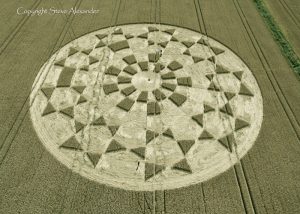 Get your own photo of the Etchilhampton (2) formation to frame or to study further – see here. We have a really beautiful 10 x 15 inch print available on our shop you can see the overhead image They are priced at just £20.00 plus postage and look fabulous framed on any wall.
Get your own photo of the Etchilhampton (2) formation to frame or to study further – see here. We have a really beautiful 10 x 15 inch print available on our shop you can see the overhead image They are priced at just £20.00 plus postage and look fabulous framed on any wall.
Etchilhampton Watercolour Painting: Anyone wanting a print, or the original of my Etchilhampton painting, please contact us to order one. The prints are £50 each and the original is for sale at £150.00.


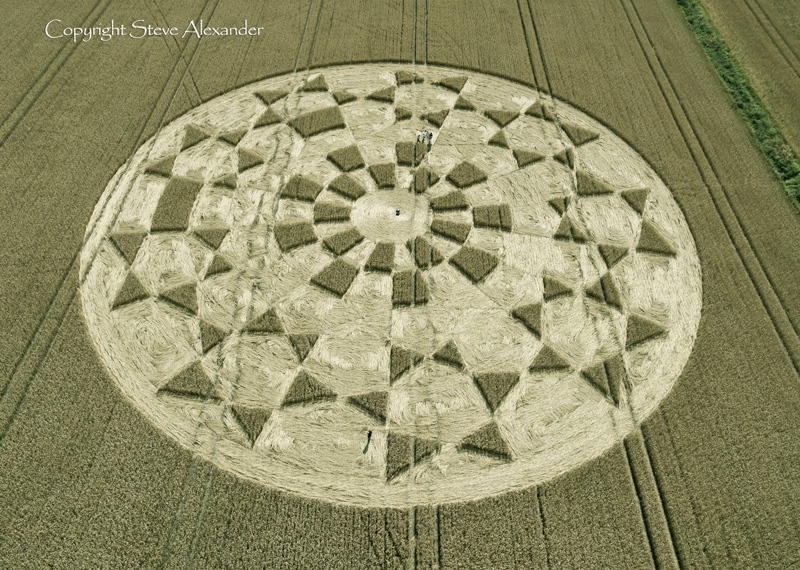
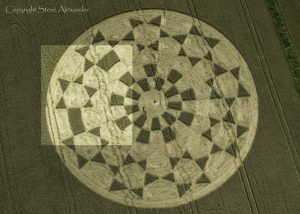
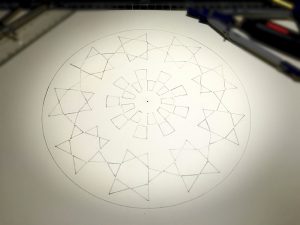
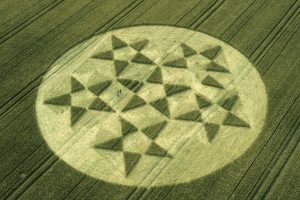
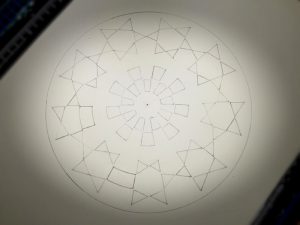
Karen’s timely article is a wakeup call to Humanity, to those of us with the courage and understanding to go forward from this point. The crop circles have been on my path for several years now, for they do pose a huge challenge to the Scientific Method which has underlined the progress of Humanity over the centuries. Paradigm shifts are always very difficult and challenging, because they require us to change our thinking patterns. These circles have been very enlightening in a way that cannot be defined in scientific terms. They push the boundaries of consciousness at the subconscious level.
Thanks Karen for a wonderful essay on this formation and on how we look at and approach paranormal phenomena. You state it well when you say we have been applying old-world modes of understanding to the puzzle of crop circles and paranormal phenomena. Author Keith Thompson once described the revolving door of Human-UFO interactions as “…the continuing unsolvability of the UFO phenomenon by conventional means and models, coupled with the continuing manifestation of the phenomenon…”. Thompson’s description can be equally applied to crop circles and other paranormal phenomena. The need, which you point out so clearly, for integrating the physical aspects of these phenomena with the non-physical aspects is both necessary and long overdue. The late John Mack also wrote about the need to consider both of these aspects in considering anomalous phenomena.
I haves shared “Blocks to Understanding” with ten people and also put a link to your essay on the facebook page for my e-book interview with journalist and UFO researcher Leslie Kean.
Your explanations and commentary on matters crop circle warm my heart. I have always been interested in the effects of the non-physical. I find your words and subtle encouragement like an invitation for your readers to be more open to unfamiliar explanantions and commentary. There’s room for all of us. It was quite evident in the recent Online Workshop that you put on in April – which I enjoyed too – and the informative materials you sent to us. It was good seeing and sharing your illustrations. You invited the participants to be open to the world of possibility, to sit with the question. In response I think we must become adept at using our anxiety for good. Life will always be uncertain. It’s time get to know my shadow side, my butterflies, my little voice.
P.S. Have you ever considered publishing a quarterly journal of your crop circle writings? It could serve the dual purpose of getting your writings disseminated, while also raising funds through subscriptions for the work that you and Steve do. David Spangler does something similar with his writings and work.
Hi Steve,
Thanks for the suggestion Steve. I used to love the old quarterly journals – I even produced one for a while. I love the idea, but I also know it would be very time consuming and it would be expensive to print. I also know that most people use the internet now to access information and that there is huge resistance to pay for content with most thinking internet content should be free – how to cover costs is a huge problem facing many people who run websites. It’s a problem society has yet to solve as a whole – news media in particular are facing similar problems.
HI Karen,
You’re right of course, printing costs are high. Yet, I remain surprised at finding no evidence online of even a single crop circle monthly or quarterly publication in English. How about a quarterly or even an annual journal that collects your writings? You could eliminate most costs by publishing it internationally as both an e-book, through Amazon, and as a print-on-demand book through Amazon’s subsidiary, CreateSpace.
And speaking of David Spangler, in my comment above, I was wondering if you knew if he or Dorothy McLean or others have ever spoken about crop circles in relation to the nature kingdoms?
Re: Steve Donoso’s question about ‘Elemental Beings / Nature Kingdoms’
I certainly believe that there could very well be a relationship between the CC and these Beings. There are Nature Spirits everywhere and the fact that CC appear in a living entity, indicates a mutual relationship. (although I was taken aback upon seeing / touching the non-organic soils heavily permeated with chemical fertilizers) I suppose if ‘they’ are attempting to convey a message, then the medium (soil & crops) are somewhat irrelevant.
(Would you eat the grains from these fields ?)
Thank Karen you could not of said it better, (we test it’s physical matter, because we want to be seen as credible investigators and taken seriously by our peers and society)
So here is the answer to your question , the formations is a message of free energy and the majority of crop circles is the ufo community showing us how to make and use free energy in several different formations. The 999 or 911 is because we the people of the world are building nuclear energy and to many times has gone wrong. Everyone should have free and safe energy with this new technology , not only will it power the world into the future but into outter space and beyond our wildest dreams
Thanks for your comment Joseph – If that’s the case I hope someone works it all out quickly!
Hi some cool theories, was wondering if anyone has looked at these circles like a fractal antennae blueprint, that is build it and contact us, just wondering.
Thanks James
This appears to be the circle that is mentioned in the book “From Deep Space With Love” by Mike Dooley and Tracy Farquhar. It’s on page 80 if you’re curious.